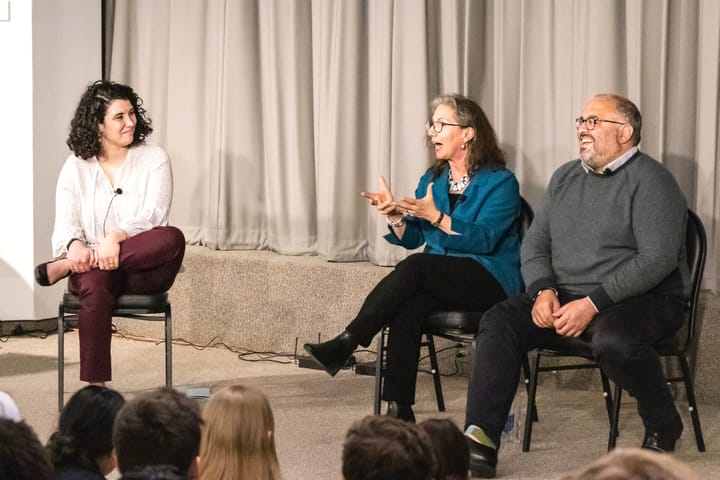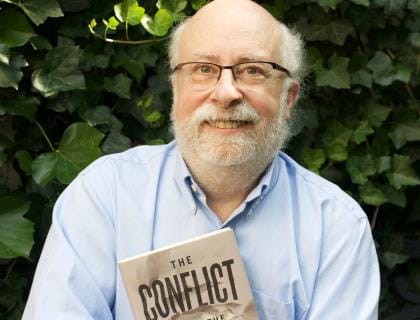Headlining Litfest 2021, Charles Yu, Megha Majumdar Spotlight Asian American Identity
LitFest 2021 featured 2020 National Book Award for Fiction winner Charles Yu and nominee Megha Majumdar in a virtual conversation moderated by Thirii Myo Kyaw Myint, a visiting writer at the college on Feb. 26. Responding to questions posed by Myint and audience members, Yu and Majumdar spoke about topics ranging from the surging anti-Asian racism in the U.S. to how they wrestle with such issues through their writing.
LitFest commemorates the college’s literary tradition by hosting various artists throughout the week. A distinguished array of authors, poets and other writers give lectures, perform and have conversations with the community. This year’s sixth annualLitFest was, for the first time ever, held completely online.
Yu, whose parents immigrated to the U.S. from Taiwan, is the author of four books, including “Interior Chinatown,” which won the 2020 National Book Award for Fiction. Using an unconventional screenplay format, “Interior Chinatown” follows the life and story of the actor Willis Wu in an exploration of what it means to be Asian in America. Majumdar was born and raised in Calcutta, India. She moved to the U.S. at the age of 19 to attend Harvard University. “A Burning,” her first book, is set in her home country of India and was long-listed for the National Book Award.
The conversation on Friday was squarely situated in context of an increasing frequency of anti-Asian hate crimes fueled by misinformation during the Covid-era. Myint opened the dialogue by asking how the authors are responding to the current circumstances and perceptions surrounding Asian Americans.
“You know, watching this horrible surge in anti-Asian sentiment and attacks has been horrifying, and yet, not entirely shocking,” answered Yu. “It is almost like a confirmation of an anxiety that doubles under the surface for me, which is, you know, stay invisible, stay invisible.”
“In some ways, I wrote ‘Interior Chinatown’ to try to grapple with some of these questions of ‘What is it, if anything, [that is] unifying to an Asian American experience?” he continued. “Is there some feature of trying to hide or step into the background of a narrative that doesn’t usually feature Asian Americans? How do you humanize subjects that are not often the protagonists of their own stories?”
Majumdar also spoke about how important it is to her to push past stereotypes and clichés and express all the contradictions within her characters. “A question [I grappled with in writing my book was], how do I write these characters with as much complexity as possible?” she said. “How can I make them greater than their struggle, because yes, I want to write about the struggle, but I also want to write about the ways in which they hold onto joy. That complexity, that humanness, felt extremely important to preserve.”
Other questions concerned how the authors came up with the ideas for their books, what their writing process looks like and who their literary inspirations are. Throughout the conversation, the power of writing to provide a lens into people’s lived experiences and change the discourse surrounding the Asian American experience remained a recurring theme.
“There was, for this book in particular, a goal of putting an imaginary reader into shoes that they have not been in — you know, to be someone like Willis, to be a background Asian male,” said Yu. “I imagine[d] that there would be non-background-Asian-males reading it at some point.”
“I am an immigrant,” Majumdar said when asked to reflect on how the nomination for the National Book Award has affected her. “To receive this kind of American recognition, to see my book, which is set in India, be recognized as part of the conversation around American literature, it was incredibly moving for me.”
Speaking more broadly, she added, “All of the Asian American voices that we are able to read right now, [that are] deepening our understanding of all the different experiences that are encompassed by this term ‘Asian American’ and the nuances of each of those experiences — I think the more deeply we can understand them, the better off we will be.”
Several students who attended the event reported that the conversation and the works of the featured authors resonated deeply with them. “I would describe it as kind of a painful relatedness,” said Steven Yu ’23 on the experience of reading “Interior Chinatown.”
“The book makes you think a lot of assimilation — when have you assimilated, will you ever assimilate,” he reflected. “There’s this line toward the end, where he [Willis] recognizes that even though he’s reached the point of [being] Kung Fu Guy, he still falls under this umbrella of being a generic Asian man.”
Mica Nimkarn ’24 added, “It[’s] a lot easier as an Asian American to relate to the stories, because you’re like, that’s a character in a book that has the same experience as me, and that’s not something that happens often.”
Students also appreciated that the event spotlighted experiences that don’t always get much attention in mainstream media. “I think both [Yu and Majumdar] really riffed off each other in terms of talking about the current events that are happening and how to handle it as an Asian person in America,” Nimkarn said. “I found that really helpful because I think all of us are kind of coming to terms with the violence, [and] also how people aren’t talking about it.”
“I just thought it was a phenomenal event,” said Mayesha Ahmed ’22. “I thought that it was just a rare spectacle in terms of these individuals, these writers, these works that you probably wouldn’t expect to reach out to a wide audience [and] the fact that Amherst decided to feature them and show their stories.”
An aspiring writer who immigrated from Bangladesh to the US just a few years ago, Ahmed found the conversation to be particularly inspiring. “For me, [hearing their stories] has changed my conception of the difference that I can make in people’s lives, being an immigrant and being Asian American — [of] how much influence I can have in the narrative, in the social narrative of America,” she said.





Comments ()